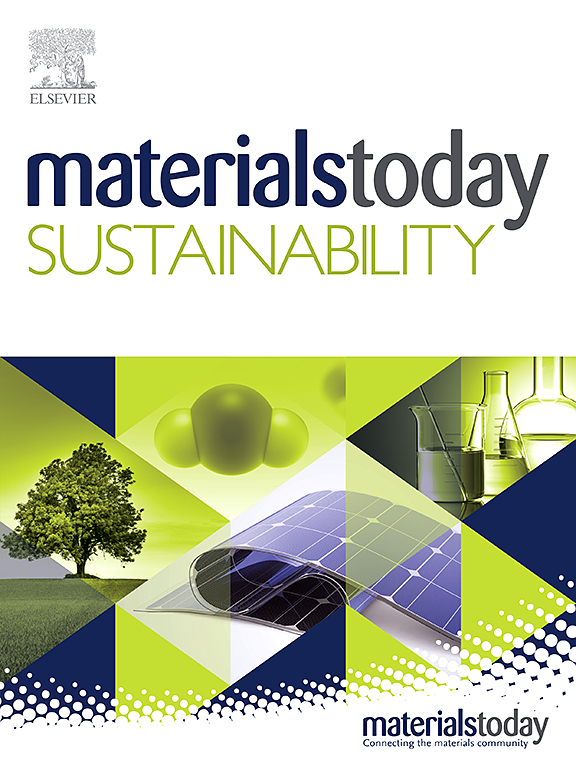工业、农业和建筑废弃物在胶凝复合材料中的利用:对其对混凝土性能和可持续建筑实践影响的全面回顾
IF 7.1
3区 材料科学
Q1 GREEN & SUSTAINABLE SCIENCE & TECHNOLOGY
引用次数: 0
摘要
全球对混凝土的需求不断上升,再加上水泥生产对环境的影响,有必要探索可持续的替代品。本文旨在定量评价工业、农业和建筑业的发展潜力。拆除(C&;D)废物作为补充胶凝材料(SCMs)或混凝土中的骨料替代品。一项全面的文献综述评估了用这些废料改性的混凝土的机械、物理和微观结构性能。关键参数,如抗压强度,抗弯强度,和易性和耐久性在不同的更换水平进行了分析。结果表明,掺加粉煤灰(FA,最优掺量:10-20%)可使混凝土28 d抗压强度提高30%,同时降低透气性,提高15-20%的长期耐久性。矿渣(GGBFS)替代量为30%时,抗压强度可提高25%,偏高岭土(MK,最佳替代量为10%)可改善孔隙结构,提高强度40%。稻壳灰(RHA)替代量为20%时,抗压强度可提高25%,但可加工性降低10-15%。棕榈油燃料灰(POFA, 10-20%替代品)也显示出15-20%的强度增益,尽管需要仔细处理以保持可加工性。玉米芯灰(CCA, 10%替代)可适度提高强度10-15%。对于C&;D废物,废玻璃(10-30%的替代品)减少了对环境的影响,并提高了抗压强度高达20%。废陶瓷(10-50%替换)可提高抗压强度15-25%,耐久性20-30%。废橡胶,主要用于能量吸收在5-25%的替代,提高延展性高达50%,虽然它会略微降低5-10%的抗压强度。本综述证实,将废料掺入混凝土可提高其机械性能并减少其环境足迹。然而,材料组成的可变性、混合设计的优化和长期性能评估需要进一步研究。定量分析为有效利用混凝土中的废料提供了明确的指导方针,有助于建设一个更可持续的建筑行业。本文章由计算机程序翻译,如有差异,请以英文原文为准。
Utilization of industrial, agricultural, and construction waste in cementitious composites: A comprehensive review of their impact on concrete properties and sustainable construction practices
The escalating global demand for concrete, coupled with the environmental impact of cement production, necessitates the exploration of sustainable alternatives. This paper aims to quantitatively evaluate the potential of industrial, agricultural, and construction & demolition (C&D) waste as supplemental cementitious materials (SCMs) or aggregate replacements in concrete. A comprehensive literature review assessed the mechanical, physical, and microstructural properties of concrete modified with these waste materials. Critical parameters such as compressive strength, flexural strength, workability, and durability were analyzed at various replacement levels. The results show that fly ash (FA, optimal replacement: 10–20%) can improve compressive strength by up to 30% at 28 days while reducing permeability and increasing long-term durability by 15–20%. Ground Granulated Blast Furnace Slag, GGBFS) at 30% replacement enhances compressive strength by 25%, and Metakaolin (MK, optimal replacement: 10%) can refine pore structure and increase strength by 40%. Rice Husk Ash (RHA) at 20% replacement improves compressive strength by up to 25% but decreases workability by 10–15%. Palm Oil Fuel Ash (POFA, 10–20% replacement) also shows strength gains of 15–20%, though it requires careful processing to maintain workability. Corn Cob Ash (CCA, 10% replacement) demonstrates moderate strength improvement of 10–15%. For C&D wastes, waste glass (10–30% replacement) reduces environmental impact and enhances compressive strength by up to 20%. Waste ceramic (10–50% replacement) improves compressive strength by 15–25% and durability by 20–30%. Waste rubber, primarily used for energy absorption at 5–25% replacement, enhances ductility by up to 50%, though it slightly reduces compressive strength by 5–10%. This review confirms that incorporating waste materials into concrete enhances its mechanical properties and reduces its environmental footprint. However, variability in material composition, optimization of mix designs, and long-term performance assessment require further research. The quantitative analysis provides clear guidelines for effectively utilizing waste materials in concrete, contributing to a more sustainable construction industry.
求助全文
通过发布文献求助,成功后即可免费获取论文全文。
去求助
来源期刊

Materials Today Sustainability
Multiple-
CiteScore
5.80
自引率
6.40%
发文量
174
审稿时长
32 days
期刊介绍:
Materials Today Sustainability is a multi-disciplinary journal covering all aspects of sustainability through materials science.
With a rapidly increasing population with growing demands, materials science has emerged as a critical discipline toward protecting of the environment and ensuring the long term survival of future generations.
 求助内容:
求助内容: 应助结果提醒方式:
应助结果提醒方式:


